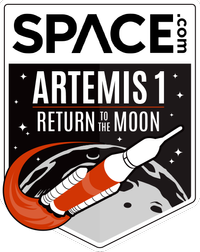

NASA's Artemis 1 moon rocket is seeking shelter from the storm.
The space agency began rolling the Artemis 1 stack — a Space Launch System (SLS) rocket topped by an Orion crew capsule — off Kennedy Space Center's (KSC) Launch Pad 39B Saturday (Sept. 26) at 11:21 p.m. EDT (0321 GMT on Sept. 27).
Artemis 1 headed for KSC's huge Vehicle Assembly Building (VAB), where it will be safe from Hurricane Ian, should the storm's lash fall on Florida's Atlantic coast. The roughly 4-mile (6.4 kilometers) journey to the VAB, made atop NASA's venerable crawler transporter-2 vehicle, took nearly 10 hours; Artemis 1 arrived at about 9:15 a.m. (1315 GMT) on Tuesday (Sept. 27), NASA officials said in an update.
Related: NASA's Artemis 1 moon mission: Live updates
More: 10 wild facts about the Artemis 1 moon mission
This wasn't Artemis 1's first rollback; the vehicle also departed Pad 39B for the VAB in April and July of this year after conducting fueling tests. The SLS and Orion made it back to the pad in mid-August ahead of a liftoff attempt on Aug. 29.
That try was foiled by a technical glitch, and a leak of liquid hydrogen propellant scuttled a subsequent launch attempt on Sept. 3. The Artemis 1 team fixed the leak and started preparing for another planned try on Tuesday (Sept. 27), but then Hurricane Ian intervened.
It's unclear at this point if Ian is indeed going to hammer Florida's Atlantic coast; the most recent models have the storm taking particular aim at the Sunshine State's Gulf side. But NASA decided early Monday morning (Sept. 26) to play it safe and get Artemis 1 inside the VAB.
Get the Space.com Newsletter
Breaking space news, the latest updates on rocket launches, skywatching events and more!
Artemis 1 team members have said they'll likely perform some maintenance work at the VAB, including resetting the batteries for the mission's flight termination system (FTS), which is designed to destroy the SLS if it veers off course during launch.
The FTS batteries were initially certified for just 20 days on the launch pad, and that time was up a while back. The U.S. Space Force, which oversees the Eastern Range of rocket launches, granted two certification extensions, which covered an Artemis 1 liftoff through at least early October. But it makes sense to reset the FTS batteries if the vehicle is at the VAB anyway, NASA officials have said.
It's too soon to speculate about a new Artemis 1 target launch date; we'll just have to wait for more information from NASA.
Editor's note: This story was updated at 11:40 a.m. EDT on Sept. 27 with news of Artemis 1's arrival at the VAB.
Mike Wall is the author of "Out There" (Grand Central Publishing, 2018; illustrated by Karl Tate), a book about the search for alien life. Follow him on Twitter @michaeldwall. Follow us on Twitter @Spacedotcom or on Facebook.
Join our Space Forums to keep talking space on the latest missions, night sky and more! And if you have a news tip, correction or comment, let us know at: community@space.com.

Michael Wall is a Senior Space Writer with Space.com and joined the team in 2010. He primarily covers exoplanets, spaceflight and military space, but has been known to dabble in the space art beat. His book about the search for alien life, "Out There," was published on Nov. 13, 2018. Before becoming a science writer, Michael worked as a herpetologist and wildlife biologist. He has a Ph.D. in evolutionary biology from the University of Sydney, Australia, a bachelor's degree from the University of Arizona, and a graduate certificate in science writing from the University of California, Santa Cruz. To find out what his latest project is, you can follow Michael on Twitter.
